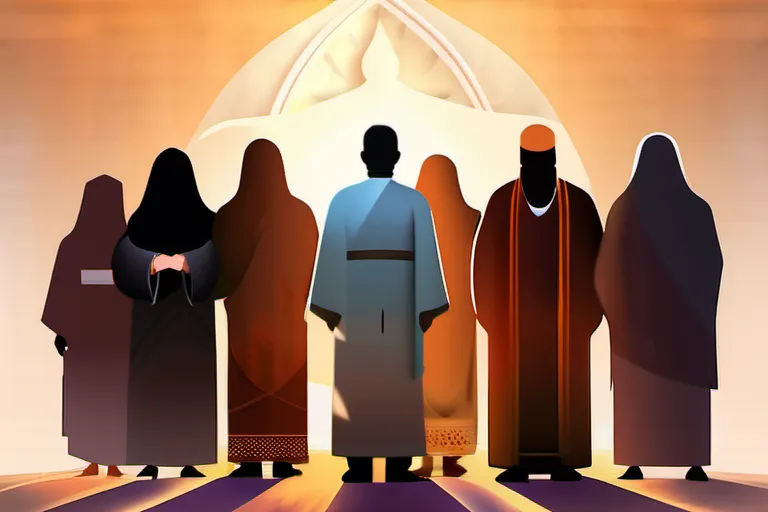Exploring the historical, cultural, and psychological factors that fuel religious disputes worldwide.
Religious conflicts have been a persistent feature of human history, causing immense suffering and division. In this article, we delve into the complex web of reasons behind these disputes, shedding light on their origins and consequences.
The Historical Context of Religious Conflict
Imagine history as a vast, complex tapestry woven from threads of power and conflict. How did these threads intertwine to create the intricate patterns we see in religious disputes today? The roots of religious conflict stretch far back into time, often born out of historical events that laid the groundwork for enduring tensions.
Consider this: Was it really just a matter of religion or beliefs that caused the Crusades, or was there something deeper at play? Historical events like these can be seen as battles not just of faith but of empires and ideologies. The Crusaders saw themselves as champions of Christianity, reclaiming holy lands from Muslim rulers. But what drove the Muslim powers to resist so fiercely?
The answer lies in the power dynamics of the time. These conflicts often stemmed from a struggle for dominance over trade routes, resources, and territories. It’s like a game where players try to expand their territory by any means necessary—religion was just one piece in this grand strategy.
Moreover, these historical struggles have left deep scars that continue to influence religious conflict even today. For example, the tensions between Christian and Muslim communities in the Middle East can be traced back to centuries of competing empires and political alliances. These long-standing grievances often resurface when religious identities are invoked as a means to rally support or justify actions.
In this complex web of history, it’s essential to recognize that religious conflict is rarely about religion alone. It’s a reflection of broader social, economic, and political issues. By understanding these historical roots, we can better navigate the complexities of modern religious conflicts and work towards more peaceful resolutions.
Cultural Factors Contributing to Religious Disputes
How do cultural differences shape religious disputes? It’s like two ancient rivers meeting, each carrying its own sediment and flow. One might argue that cultural factors are the bedrock upon which these conflicts are built. These traditions, customs, and social norms often act as invisible barriers between communities, sometimes leading to misunderstandings and tensions.
Take for example the Middle East, where ancient traditions clash with modern interpretations of religion. In many societies, religious practices are deeply intertwined with daily life—food, dress codes, and even how one greets another. When these traditions differ significantly from those of neighboring communities or groups within the same region, it can lead to resentment and conflict.
Imagine a village where everyone adheres strictly to traditional religious rituals, while just a few miles away, people embrace a more liberal interpretation. The rigid adherence in one community might be seen as oppressive by others, leading to strained relations and potentially violent confrontations. These cultural differences can act like sharp knives cutting through the fabric of society, creating rifts that are hard to mend.
Cultural factors also play a role in how different groups perceive their identity and place in the world. In some cases, these perceptions can lead to an “us versus them” mentality, where one group sees itself as superior or threatened by others. This us-versus-them mindset is often fueled by historical grievances and current social dynamics, making it difficult for dialogue and understanding.
Moreover, the way cultural practices are transmitted from generation to generation can reinforce these differences. Stories, songs, and rituals passed down through families and communities shape beliefs and attitudes towards other groups. These narratives often highlight perceived threats or injustices, which can escalate into full-blown conflicts if left unaddressed.
Understanding how cultural factors contribute to religious disputes is crucial for finding peaceful resolutions. By recognizing the deep-seated traditions that drive these conflicts, we can begin to see beyond the surface-level disagreements and work towards mutual respect and understanding.
The Psychology of Religious Conflict
Can we truly understand religious conflicts without delving into the depths of human psychology? Imagine a battlefield where instead of weapons, emotions and beliefs clash—this is often the theater of religious conflict. But what drives individuals to become so deeply entrenched in their positions that they are willing to wage war over them?
‘Isn’t it strange how our minds can turn what should be a source of unity into a reason for division?’
Psychology plays a crucial role here. Cognitive dissonance theory, a key psychological concept, suggests that people experience discomfort when they hold two conflicting beliefs simultaneously. This discomfort often leads to a strong urge to resolve the conflict by adjusting one’s beliefs or attitudes. In religious contexts, this can manifest as an intense desire to defend one’s faith against perceived threats.
The need for belonging and identity also fuels these conflicts. Just like a tree needs roots to grow, individuals often find their sense of self through their religious affiliations. When challenged, they might feel that their very identity is under attack, leading to aggressive defense mechanisms.
Moreover, the phenomenon known as “us versus them” psychology is prevalent in many conflicts. It’s as if we mentally create a divide between those who are like us and those who aren’t. This divide can be exacerbated by leaders who use inflammatory rhetoric, framing their own group as pure and threatened, while labeling others as corrupt or evil.
But isn’t it fascinating how these psychological mechanisms are often at play without our conscious awareness? We might be drawn into conflicts without fully understanding the emotional and cognitive forces that propel us. Understanding these inner dynamics is crucial for anyone seeking to resolve religious disputes peacefully—by addressing the underlying psychological needs and biases that fuel them.
Religious Conflict and Identity Formation
Religious conflict often emerges from deeply rooted identity issues, where individuals and groups perceive their very existence as threatened by differing beliefs. How do we define ourselves when our religious identity is challenged? Isn’t it like a fragile flower, easily bruised by conflicting winds? In times of tension, one’s faith can become not just a personal belief but an integral part of one’s self-identity.
Identity as a Battleground: When religious identities clash, the battlefield expands beyond mere theological debates. It becomes about who gets to define reality, what values should guide society, and how communities choose to live their lives. Imagine two tribes in an ancient forest, each holding sacred beliefs that dictate their way of life—what happens when these paths inevitably cross? The conflicts that arise are not just spiritual but deeply emotional and psychological.
Consider the case of Jehovah’s Witnesses and the Catholic Church. Both groups share a common belief in the importance of their religious teachings, yet they diverge sharply on various issues. When such fundamental differences come to light during times of societal change or crisis, tensions can escalate quickly. These conflicts highlight how deeply intertwined religious identity is with personal values and group cohesion.
The dynamics of group behavior in these scenarios are fascinating. In moments of conflict, individuals often rally around their religious beliefs as a form of solidarity. This unity is both a strength and a weakness. While it strengthens the group’s resolve to uphold its beliefs, it can also lead to intolerance towards outsiders who do not share those same convictions. How does one navigate this tightrope between maintaining faith and embracing diversity?
In conclusion, religious identity plays a crucial role in shaping behavior during conflicts. It’s a complex interplay of personal beliefs, group dynamics, and societal pressures that can either unite or divide people in profound ways. As we explore further into the history of these conflicts, understanding this identity formation process will be key to grasping their full impact.
Case Studies: Major Religious Conflicts Throughout History
Let’s delve into some pivotal moments that have etched their mark on history, marking significant conflicts fueled by religious fervor: the Crusades, the Thirty Years’ War, and the Indian-Pakistani Partition. Each of these events stands as a testament to how deeply intertwined religion can be with political power and territorial disputes.
Imagine the Crusades as a grand theater of medieval Europe, where Christian knights were embroiled in a holy quest to reclaim the Holy Land from Muslim control. These conflicts spanned over two centuries, marked by battles, sieges, and massacres that reshaped political landscapes and religious identities. How did a call for a holy war turn into such a bloody saga? The answer lies in the complex interplay of religious zealotry, political ambition, and social upheaval.
The Thirty Years’ War, which ravaged much of central Europe from 1618 to 1648, serves as another sobering reminder. This conflict was originally a religious dispute between Protestants and Catholics but quickly spiraled into a multifaceted war involving states and their own political agendas. The war left entire regions in ruins and millions dead. It prompts us to ask: how can religious differences become so incendiary that they incite such catastrophic violence?
The Indian-Pakistani Partition, which followed the partition of British India in 1947, is perhaps one of the most poignant examples. This division was not just about religion but also about nationalism and identity. The resulting displacement of millions and violent conflicts between Hindus, Muslims, and Sikhs underscored how deeply intertwined religious identities are with national aspirations. Could secularism have prevented this bloodshed? Or were the roots too deep in communal tensions to be easily resolved?
These case studies reveal that the roots of religious conflict are complex, multifaceted, and often go beyond just religious differences. They intertwine with historical grievances, economic disparities, political maneuvering, and social norms. By examining these conflicts through a comprehensive lens, we can better understand how to approach and perhaps prevent such disputes in the future.
Modern Approaches to Resolving Religious Conflict
As we delve into modern approaches to resolving religious conflicts, it’s essential to understand that these strategies are not just about stopping violence; they’re about fostering mutual understanding and respect. How do we bridge the gaps between differing beliefs? Can dialogue truly heal the wounds of centuries-old disputes?
‘Can two walk together unless they agree?’ asks the Book of Amos, posing a rhetorical question that challenges us to find common ground.
Diplomacy plays a pivotal role in these efforts. It’s not just about negotiating treaties; it’s about building trust and fostering environments where diverse faiths can coexist peacefully. For instance, during the Middle East Peace Process, diplomats worked tirelessly to address not only political grievances but also religious sensitivities, recognizing that peace requires more than mere agreements on paper.
Dialogue, too, is a powerful tool. Conferences like the Rabat Dialogue, which brings together leaders from different religions and cultures, aim to foster open and honest conversations. These dialogues are not just about sharing opinions but also listening deeply to understand the other side’s perspective. It’s like peeling back layers of an onion, revealing the core truths that bind us all as human beings.
Interfaith cooperation is another approach gaining traction. Organizations like the American Jewish Committee, Muslim-Christian Solidarity Network, and Sikhs for Justice work to build bridges between communities, organizing joint events, educational programs, and community service projects. These initiatives are crucial in showing that despite our differences, we share common goals of social justice and peace.
In conclusion, the path towards resolving religious conflicts is complex but achievable with concerted effort. By embracing diplomacy, dialogue, and interfaith cooperation, we can build a world where diverse faiths coexist harmoniously, transforming conflicts into opportunities for mutual growth and understanding.
Conclusion
 By understanding the underlying causes of religious conflict, we can work towards promoting peace, tolerance, and mutual respect among different faiths.
By understanding the underlying causes of religious conflict, we can work towards promoting peace, tolerance, and mutual respect among different faiths.











